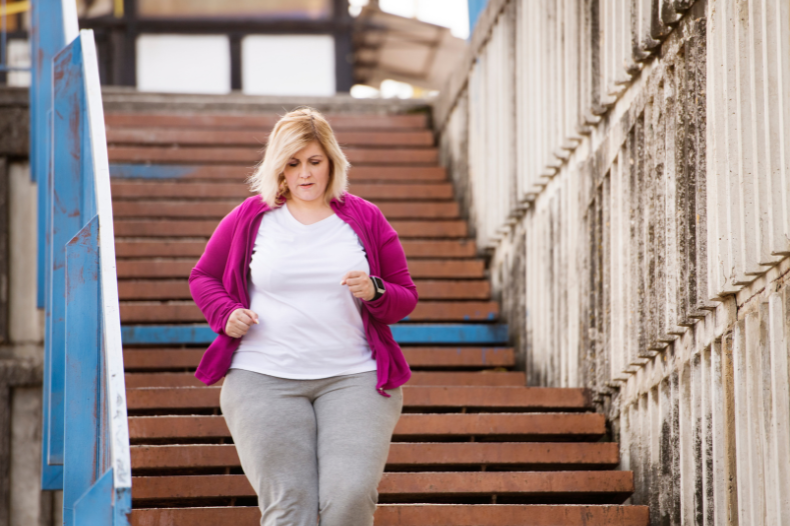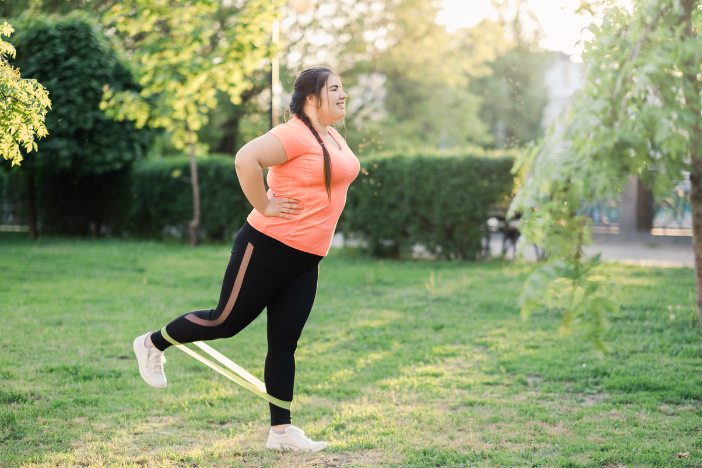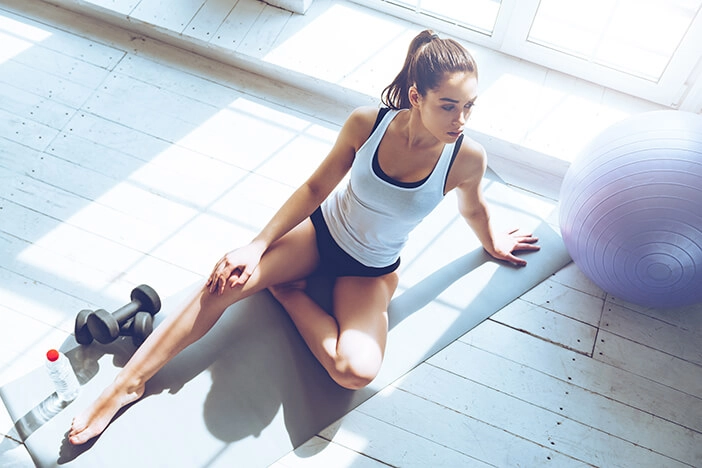1. Review - Quiz
How can you finally change your behavior sustainably and achieve your goals?
Movement in everyday life – a topic that is often overlooked in today’s world. In this lesson we’ll take a look at why everyday movement is so crucial to our health and how we can integrate it into our daily routine despite the challenges of our sedentary lifestyle. Let’s set out together on the path to a more active and healthy life!
2. Why exercise is so important

The importance of exercise extends far beyond gyms and sports fields. Our bodies are designed to move and neglecting this has consequences for our health. Everyday exercise offers much more than just physical fitness. Not only does it keep our bodies in shape, but it also contributes to mental clarity and strengthening the immune system. Our modern lifestyle often promotes static behavior, from long hours in the office to leisure activities. Hours of sitting are proven to have a detrimental effect on our health. Let’s find effective ways together to integrate more exercise into our everyday lives.
2.1 The benefits of exercise in everyday life
Daily exercise not only keeps the pounds at bay, but also supports the health of our organs and muscles as well as our mental health.
Positive effects of exercise on the body
Positive effects of exercise on mental health
Overall, exercise in everyday life not only contributes to physical fitness, but also has a significant influence on general well-being.
3. Find Fun in Movement
Not everyone always enjoys exercise. This can be due to various things, but most often it is the case that we “force” ourselves to do a movement or sport that we actually don’t like and that we don’t enjoy.
Some people love running, for others there is nothing worse.
So try to find a sport or activity that you enjoy! Here is an overview of sports and everyday activities, which muscles they train and how many calories you burn.
You see: someone who works hard in the garden burns just as many calories as someone who lifts weights in the gym. So it depends on what exactly brings you joy!
4. Too unmotivated to exercise? Finally manage to get up from the sofa!

I think everyone knows it: you come home after a long day and all you want to do is sit on the sofa, have some dinner and watch TV. Unfortunately, this is not good for our health in the long term. We need movement! So how can you detach yourself from the couch when it attracts you like a magnet? Here are our 10 tips!
1. Find something you enjoy
Choose activities that bring you joy. Whether it’s dancing, walking, or gardening, if it’s fun, you’re more likely to stick with it.
2. Set clear goals
Define clear and achievable goals. Instead of committing to exercising for hours every day, you could start with small goals, like walking for 30 minutes a day.
3. Find a training buddy
Exercising with others is often more fun. Find a workout partner or join a group to motivate each other.
4. Reward yourself too!
Set up a reward system where you give yourself special rewards for regular exercise. This can be a spa day, a night out with friends, a quiet evening with a good book – whatever rewards you. It just shouldn’t be food.
5. Variety
Long-term motivation is promoted by variety. Try different sports or activities to avoid boredom.
6. Record your progress
Document your progress in a diary or app. Looking at achieved goals can serve as an incentive to continue to be active.
7. Everything becomes easier with music
Create playlists with motivating music for your training sessions. The right soundtrack can increase energy and make exercise more enjoyable. There are even playlists for cleaning!
The Ultimate Cleaning Playlist – playlist by POPSUGAR Smart Living | Spotify
8. Use challenges
Set yourself challenges, be it in the form of virtual challenges or other sporting goals (run a certain distance, lift a certain weight, etc.). Striving for new challenges can be motivating.
9. Use technology to your advantage
- Fitness apps: Apps like “Nike Training Club” or “Gymondo” offer workouts and help track progress.
- Activity tracker: Devices like Fitbit or Apple Watch record your daily activities and give you an overview of your movement.
- Digital training plans: Online platforms such as YouTube or other online providers offer a variety of training options with instructions.
10. Overcome your inner demons
Give yourself courage and recognize your own successes. Positive self-talk can strengthen internal motivation. Also use the 5-minute rule: Start your activity and plan to do it for 5 minutes. You can stop after 5 minutes if you don’t feel like it anymore. The background: Most of the time you continue after you’ve already started.
5. I just can't manage any extra training - How can I move more in everyday life?
It’s absolutely not a problem if you don’t manage to exercise more. Even small changes can make your everyday life more active!
- Walks: Take short breaks to go for a walk. This can be your lunch break or you can also cover short distances on foot instead of by car.
- Stairs instead of elevator: Make a conscious decision to take the stairs instead of the elevator or escalator. This is an easy way to integrate more exercise into your everyday life.
- Stand longer or more: Stand up during phone calls or work standing up from time to time. This promotes blood circulation and prevents long periods of sitting.
- Stretching exercises at the desk: Incorporate short stretching exercises or light movements directly at your desk to relieve tension and activate the muscles.
- Active transportation: If possible, choose to bike or walk for short errands. Not only does this encourage exercise, but you also get some fresh air!
- Integrate fitness into everyday life: Short fitness exercises, such as squats or push-ups, can easily be integrated into everyday life to activate the muscles. Apply the buy-in/buy-out concept: determine a trigger to which you link a specific movement. For example, every time you get up from your desk or sit down, do 10 squats.
Movement - everyday is essential!
Exercise in everyday life is crucial for physical and mental health. Regular exercise can achieve positive effects such as improved physical fitness, increased well-being and stress reduction. Small steps, such as short walks, active breaks or consciously opting out of conveniences such as the elevator, can make a significant difference. Overcoming your inner weakness and creating habits are the key to long-term success.
Remember that every movement counts and positive changes in everyday life are possible. Start small, find joy in movement and experience how even small steps can make a big difference to your health!
The Essentials (brief)
- The body is designed to move, and neglecting exercise has been shown to have negative health effects.
- Everyday exercise has positive effects on heart health, muscles, bones, weight control, immune system, life expectancy, sleep quality, joints and energy levels.
- Exercise affects not only physical health but also mental health, including better mood, stress reduction, improved concentration, increased self-esteem and increased resilience.
- There are many sports and everyday activities that train different muscles and result in different calorie consumption. It’s important to find an activity that you enjoy.
- Setting clear goals, finding a workout buddy, rewarding yourself, adding variety to your workout, documenting progress, using music, accepting challenges, and using technology to your advantage are all effective strategies for maintaining motivation.
- Even if it’s hard to squeeze in extra exercise, small changes to your daily routine like short walks, climbing stairs, stretching at your desk, or getting active can have positive effects on your health.
- Positive self-talk, the 5-minute rule (start simple and do it for 5 minutes), and creating habits are key elements for long-term success when integrating exercise into everyday life.
- Every movement counts: even small steps can make a big difference to your health. It’s important to start with small changes and find joy in movement.
5 simple things you can implement
- Change mindset: Change the way you think about exercise. Instead of seeing it as a chore, think of it as an opportunity to do good for your body and mind. Focus on the positive effects, both physical and mental.
- Integrate into everyday life: Find ways to seamlessly integrate exercise into your everyday life. This can be short walks during phone calls, standing while working or short fitness exercises while cooking. By incorporating it into daily activities, exercise becomes a natural part of your life.
- Find training partners: Find a training partner or join a group to be active together. The social component can increase motivation, and shared activities are often more entertaining. This can also create accountability and help motivate each other.
- Bring variety to your movement: Long-term motivation is promoted by variety. Try different activities to avoid boredom. This could mean trying different sports, exploring new walking or running routes, or even adding different workouts into your routine.
- Use technology: Use technology to your advantage. Use fitness apps, activity trackers or online platforms with training instructions. Tracking progress through digital means can serve as additional motivation and help you stay focused on your goals.
Your Homework
Set a SMART exercise goal, e.g. “I want to go for a 30-minute walk in the fresh air every day.” and follow it for a week.
After the week, reflect on how the extra exercise affected your physical and mental well-being. Have you noticed any changes? How does it feel to be more active on a regular basis?
Knowledge Collection:
25 min. read article + E-book






